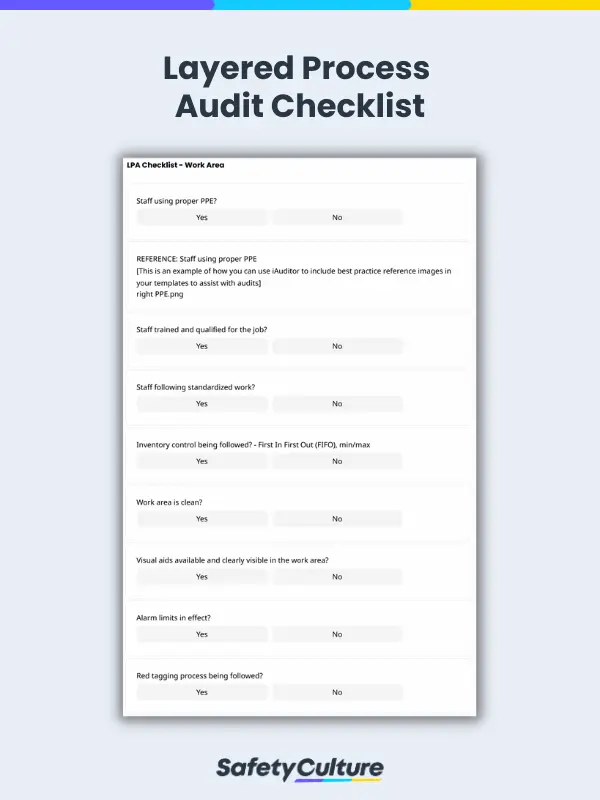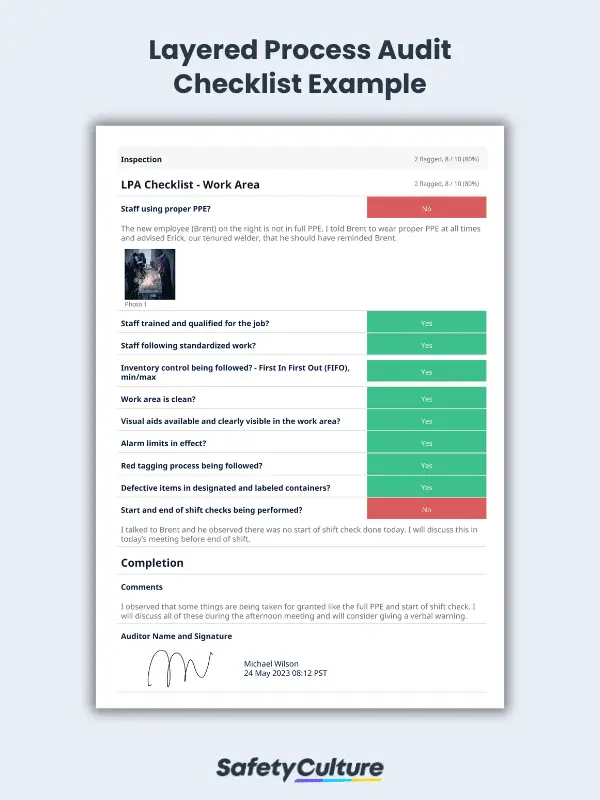What is a Layered Process Audit Template?
A Layered Process Audit (LPA) template is a structured document used by organizations to conduct regular assessments of their processes and ensure they are consistently meeting quality standards. LPA templates are typically ready-to-use but customizable so businesses will still be able to modify them according to project needs.
Why Use this Template?
Layered process audits typically involve multiple levels of inspection in an organization to ensure that manufacturing processes and procedures are being adhered to as intended. Using a checklist is especially beneficial for maintaining consistency and efficiency in the audit process.
Here are the 4 great reasons to start using a template for layered process audits:
- Structure – An LPA audit checklist ensures that all necessary steps are taken and that nothing is missed during the audit.
- Consistency – A checklist also standardizes audits across different auditors and different audits. Having a consistent questionnaire format for all audits makes it easier to compare results over time.
- Efficiency – When auditors have a handy guide of the items to check during layered process audits, they can work more efficiently.
- Thoroughness – Lastly, an LPA template is key to making sure that all necessary areas are covered during the audit.
3 Main Components of a Layered Process Audit Template
Implementing a layered process audit program entails a coordinated effort within the organization to maintain consistent quality through conformance at every stage of production. It’s important to note that an LPA audit checklist should always cater to the requirements of the customer and product. In addition, it should be tailored to the items that the assigned auditor needs to check in their scheduled audit.
Here are the 3 main components of layered process audits that should also be observed when utilizing ready-to-use LPA templates:
1. A Layer of Auditors
The goal of a layered process audit is to double-check if processes are indeed followed and ensure that non-conformance issues are immediately corrected. Assigned auditors proactively conduct identical inspections using the same layered process audit template to discover and address inefficiencies in production.
2. A Layer of Audits
A single-layered process audit checklist is used throughout the scheduled assessments, so it is ideally created through the collaboration of the layer of assigned auditors. Layered process audit templates are designed to be as short and easy to answer as possible for easier and faster reporting.
3. Audit Reporting, Follow-up, and Containment
Non-conformance and the corresponding corrective actions are then reviewed to ensure that the established processes are effective in preventing future issues. In some cases, manufacturing quality auditors use intuitive software for managing documentation and recordkeeping to help them track the status of corrective actions better.
Collected audit reports are analyzed to get an overview of trends that impact production. Reporting non-conformance and implementing corrective actions help contain the impact and avoid future occurrences of non-conformance.
How to Use an LPA Audit Checklist
Once you have your tool on hand, here’s a step-by-step guide on using a layered process audit checklist for conformance assessments:
- Provide the basic details of the audit – In this section, indicate the department, date, and location of the audit, along with the name of the auditor.
- Evaluate the conformance of staff members – See if they have received adequate training and qualifications for the job and if they’re following standard procedures in their work, including the proper use of Personal Protective Equipment (PPE).
- Observe the inventory control procedures – Verify that the inventory control in place, whether it’s First In First Out (FIFO) or ABC, is being implemented on the production floor.
- Scan the work area – Check the cleanliness of the surroundings, including the visual aids placed around the area.
- Inspect the established protocols for flagging non-conformances – Run through the alarm limits, red tagging procedures, and handling of defective items.
- Review shift checks – Confirm if start and end of shift checks are being performed regularly.
- Note your observations during the audit – Write down any areas of concern or action points that require follow-ups before signing off the report.
Example
To better illustrate how this works, here’s a layered process audit checklist example for your reference:
FAQ about Layered Process Audit Template
A process audit checklist is a tool used by auditors to help ensure that all aspects of a process are reviewed. The checklist typically includes a series of questions that must be answered during the audit.
On the other hand, a layered process audit (LPA) checklist is used to observe and validate how products are made. True to its name, this checklist covers multiple aspects of the manufacturing process in layers to eliminate non-conformances and correct issues at the source.
The frequency of performing layered process audits typically depends on the hierarchical level of personnel conducting the audits. LPAs are usually assigned to shift supervisors (for daily checks) and middle/upper management (for weekly or monthly checks).
Creating an LPA checklist falls under the responsibility of the audit management team. This team should consist of employees from all areas of the organization, such as sales, quality assurance, administration, and order fulfillment. These individuals should also have a firm grasp of the LPA process to ensure the checklist they build is specific, concise, and tailored to the needs of the product.



